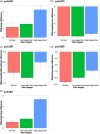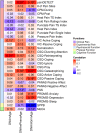Epigenetic age predictors in community-dwelling adults with high impact knee pain
- PMID: 35968561
- PMCID: PMC9380216
- DOI: 10.1177/17448069221118004
Epigenetic age predictors in community-dwelling adults with high impact knee pain
Abstract
Gerontological research reveals considerable interindividual variability in aging phenotypes, and emerging evidence suggests that high impact chronic pain may be associated with various accelerated biological aging processes. In particular, epigenetic aging is a robust predictor of health-span and disability compared to chronological age alone. The current study aimed to determine whether several epigenetic aging biomarkers were associated with high impact chronic pain in middle to older age adults (44-78 years old). Participants (n = 213) underwent a blood draw, demographic, psychosocial, pain and functional assessments. We estimated five epigenetic clocks and calculated the difference between epigenetic age and chronological age, which has been previously reported to predict overall mortality risk, as well as included additional derived variables of epigenetic age previously associated with pain. There were significant differences across Pain Impact groups in three out of the five epigenetic clocks examined (DNAmAge, DNAmPhenoAge and DNAmGrimAge), indicating that pain-related disability during the past 6 months was associated with markers of epigenetic aging. Only DNAmPhenoAge and DNAmGrimAge were associated with higher knee pain intensity during the past 48 h. Finally, pain catastrophizing, depressive symptomatology and more neuropathic pain symptoms were significantly associated with an older epigenome in only one of the five epigenetic clocks (i.e. DNAmGrimAge) after correcting for multiple comparisons (corrected p's < 0.05). Given the scant literature in relation to epigenetic aging and the complex experience of pain, additional research is needed to understand whether epigenetic aging may help identify people with chronic pain at greater risk of functional decline and poorer health outcomes.
Keywords: Biological aging; aging biomarker; chronic pain; epigenetic aging; pain biomarker.
Conflict of interest statement
Figures



Similar articles
-
Socioeconomic Status, Knee Pain, and Epigenetic Aging in Community-Dwelling Middle-to-Older Age Adults.J Pain. 2024 Feb;25(2):293-301. doi: 10.1016/j.jpain.2023.06.002. Epub 2023 Jun 12. J Pain. 2024. PMID: 37315728 Free PMC article.
-
Epigenetic aging, knee pain and physical performance in community-dwelling middle-to-older age adults.Exp Gerontol. 2022 Sep;166:111861. doi: 10.1016/j.exger.2022.111861. Epub 2022 May 29. Exp Gerontol. 2022. PMID: 35640781 Free PMC article.
-
Epigenetic Aging Mediates the Association between Pain Impact and Brain Aging in Middle to Older Age Individuals with Knee Pain.Epigenetics. 2022 Dec;17(13):2178-2187. doi: 10.1080/15592294.2022.2111752. Epub 2022 Aug 17. Epigenetics. 2022. PMID: 35950599 Free PMC article.
-
"Epigenetic clocks": Theory and applications in human biology.Am J Hum Biol. 2021 May;33(3):e23488. doi: 10.1002/ajhb.23488. Epub 2020 Aug 26. Am J Hum Biol. 2021. PMID: 32845048 Review.
-
Epigenetic aging: Biological age prediction and informing a mechanistic theory of aging.J Intern Med. 2022 Nov;292(5):733-744. doi: 10.1111/joim.13533. Epub 2022 Jun 20. J Intern Med. 2022. PMID: 35726002 Review.
Cited by
-
Borderline acceleration in blood epigenetic age of unclear biological importance in knee osteoarthritis progression: Specimens and data from the Osteoarthritis Initiative and Johnston County Osteoarthritis Project.Osteoarthritis Cartilage. 2025 Jun 4:S1063-4584(25)01033-7. doi: 10.1016/j.joca.2025.05.010. Online ahead of print. Osteoarthritis Cartilage. 2025. PMID: 40480605
-
The pace of biological aging helps explain the association between insomnia and chronic low back pain.Mol Pain. 2023 Jan-Dec;19:17448069231210648. doi: 10.1177/17448069231210648. Mol Pain. 2023. PMID: 37845028 Free PMC article.
-
Socioeconomic Status, Knee Pain, and Epigenetic Aging in Community-Dwelling Middle-to-Older Age Adults.J Pain. 2024 Feb;25(2):293-301. doi: 10.1016/j.jpain.2023.06.002. Epub 2023 Jun 12. J Pain. 2024. PMID: 37315728 Free PMC article.
-
Outcome-guided Bayesian clustering for disease subtype discovery using high-dimensional transcriptomic data.J Appl Stat. 2024 Jun 7;52(1):183-207. doi: 10.1080/02664763.2024.2362275. eCollection 2025. J Appl Stat. 2024. PMID: 39811087 Free PMC article.
-
The Pace of Biological Aging Predicts Nonspecific Chronic Low Back Pain Severity.J Pain. 2024 Apr;25(4):974-983. doi: 10.1016/j.jpain.2023.10.018. Epub 2023 Oct 30. J Pain. 2024. PMID: 37907115 Free PMC article.
References
-
- Dillon CF, Rasch EK, Gu Q, Hirsch R. Prevalence of knee osteoarthritis in the United States: arthritis data from the third national health and nutrition examination survey 1991–94. J Rheumatol 2006; 33(11): 2271–2279, http://www.ncbi.nlm.nih.gov/pubmed/17013996 (Accessed 13 January 2019). - PubMed
-
- Jordan JM, Helmick CG, Renner JB, Luta G, Dragomir AD, Woodard J, Fang F, Schwartz TA, Abbate LM, Callahan LF, Kalsbeek WD, Hochberg MC. Prevalence of knee symptoms and radiographic and symptomatic knee osteoarthritis in African Americans and Caucasians: the Johnston county osteoarthritis project. J Rheumatol 2007; 34(1): 172–180, http://www.ncbi.nlm.nih.gov/pubmed/17216685 (Accessed 13 January 2019). - PubMed
Publication types
MeSH terms
Substances
Grants and funding
LinkOut - more resources
Full Text Sources
Medical
Miscellaneous

